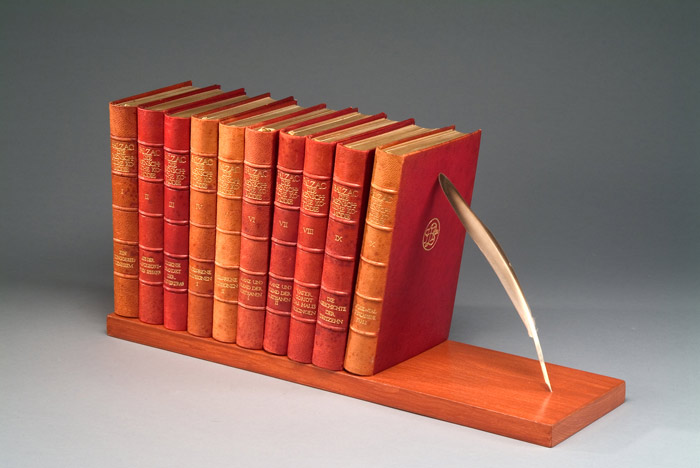“One senses in Gojowzcyk’s works that they are not exhausted in witty invention. Something higher, something spiritual, is always part of his ‘foolish game of Nothingness,’ though we may not be able to say precisely what it is. It is scarcely more than ephemeral vapor. Everything about Gojowczyk’s work is imbued with humanity,” art historian Werner Schmalenbach describes the work of contemporary artist Hubertus Gojowczyk, whose solo exhibition is currently on view at Moeller Fine Art.
Since 1968, Gojowczyk has been making book objects: works of art fabricated through the manipulation of books and other printed matter. His handling of this material is at once destructive and poetic, combining technical virtuosity with a sensitive understanding of emotion. Using alternately witty, playful, and satirical methods, his book objects transform the intellectual into the physical. In so doing, Gojowczyk allows his humble materials to shed their identity and become symbols of deconstruction, reconstruction, alienation, and transformation. The intimate, human scale of his works, combined with their ephemeral, often organic materials imparts a sense of fragility. It is precisely this quality that led Schmalenbach to assert that, “the magic of his art cannot be missed.”
Hubertus Gojowczyk was born in 1943 in the German state of Silesia (modern Poland). After receiving a degree in education, he studied at the Art Academy of Dusseldorf from 1967 to 1971. There, he worked extensively with Joseph Beuys and Dieter Roth, who is often credited with defining the modern artist’s book in the 1950s and 60s. Roth’s pioneering use of found books and publications, including comic books and newspapers, was likely a source of inspiration to Gojowczyk. In addition to regular exhibitions at Moeller Fine Art in New York and Berlin, Gojowczyk participated in Kassel’s Documenta 5 and 6 (1975, 1977). At the Documenta 6 in 1977, he showed his well-received Tür zur Bibliothek (Door to the Library.) The artist’s first US retrospective, The Book As Object, was held at Moeller Fine Art in 2005, followed by a major exhibition at the Deutsche Nationalbibliotek in Frankfurt from 2008-2009.
Moeller Fine Art’s current exhibition spans most of the artist’s career, from 1971 to 2013. At first glance, the works seem like they were drawn from a cabinet of curiosities, with natural specimens and leather-bound books vying for attention with sheaves of music and pairs of discarded spectacles. These subtle allusions to literature, art history, music, and semantics make the presentation both serious and humorous. These motifs are united by the overarching theme of time, whether in the musical sense, as in Little and Large Metronome and Four-four time Etude; the natural sense, as in the seasons of Composition and the slow decay of Ruin; or the literal sense, as in Clock II.
While these cerebral themes and allusions make for good art historical criticism, the viewer is ultimately struck by the sheer ephemeral, fragile beauty of both Gojowczyk’s material uses, and the finished works themselves. As if by magic, a feather supports volumes of Balzac, frozen in the moment just before falling. A circle of butterfly wings lifts a novel as it literally flies off the shelf. Tiny grass stems transform sheet music into a golden forest. Standing before these objects, just as if reading a book, it is easy to lose oneself in a quiet introspective moment, lit up by printed material in all of its forms and functions.
By Jeannette Sharpless
























